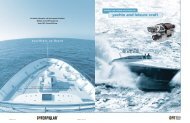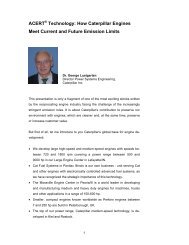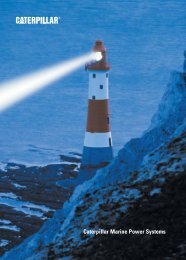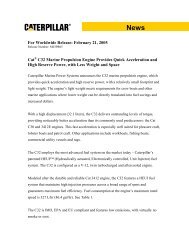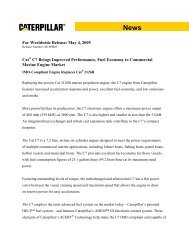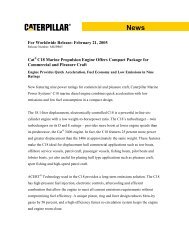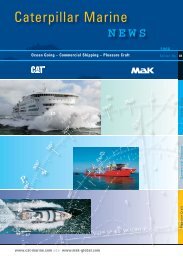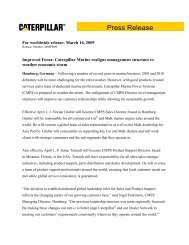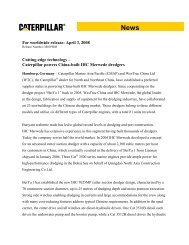POWER GUIDE - Marine Engines Caterpillar
POWER GUIDE - Marine Engines Caterpillar
POWER GUIDE - Marine Engines Caterpillar
You also want an ePaper? Increase the reach of your titles
YUMPU automatically turns print PDFs into web optimized ePapers that Google loves.
AtING DeFINItIONs<br />
<strong>Caterpillar</strong> ® marine engines are developed to perform to customer<br />
expectations in various applications. An understanding of the vessel’s<br />
intended use (load profile) allows the correct engine rating to be<br />
selected. The correct engine rating is more likely to provide the customer<br />
with engines that have an acceptable life to overhaul and good engine<br />
performance. <strong>Caterpillar</strong> marine engine ratings are determined by overall<br />
load profile, operational hours per year, and time spent at full throttle.<br />
A rating (unrestricted continuous)<br />
typical applications: For vessels operating at rated load and rated<br />
speed up to 100% of the time without interruption or load cycling (80%<br />
to 100% load factor). Typical applications could include but are not<br />
limited to vessels such as freighters, tugboats, bottom drag trawlers,<br />
or deep river tugboats. Typical operation ranges from 5000 to 8000<br />
hours per year.<br />
B rating (Heavy Duty)<br />
typical applications: For vessels operating at rated load and rated<br />
speed up to 80% of the time, or 10 hours out of 12, with some load<br />
cycling (40% to 80% load factor). Typical applications could include but<br />
are not limited to vessels such as mid-water trawlers, purse seiner,<br />
crew and supply boats, ferries, or towboats. Typical operation ranges<br />
from 3000 to 5000 hours per year.<br />
c rating (maximum continuous)<br />
typical applications: For vessels operating at rated load and rated<br />
speed up to 50% of the time, or 6 hours out of 12, with cyclical load and<br />
speed (20% to 80% load factor). Typical applications could include but<br />
are not limited to vessels such as ferries, harbor tugs, fishing boats,<br />
offshore service boats, displacement hull yachts, or short trip coastal<br />
freighters. Typical operation ranges from 2000 to 4000 hours per year.<br />
D rating (Intermittent Duty)<br />
typical applications: For vessels operating at rated load and rated<br />
speed up to 16% of the time, or 2 hours out of 12, (up to 50% load<br />
factor). Typical applications could include but are not limited to vessels<br />
such as offshore patrol boats, customs boats, police boats, some<br />
fishing boats, fireboats, or harbor tugs. Typical operation ranges from<br />
1000 to 3000 hours per year.<br />
e rating (High performance)<br />
typical applications: For vessels operating at rated load and rated<br />
speed up to 8% of the time, or 1/2 hour out of 6, (up to 30% load factor).<br />
Typical applications could include but are not limited to vessels such<br />
as pleasure craft, harbor patrol boats, harbor master boats, some<br />
fishing or patrol boats. Typical operation ranges from 250 to 1000 hours<br />
per year.<br />
3



